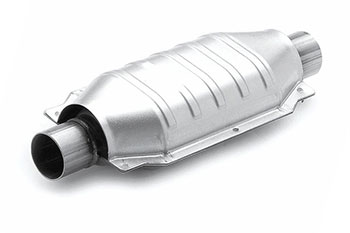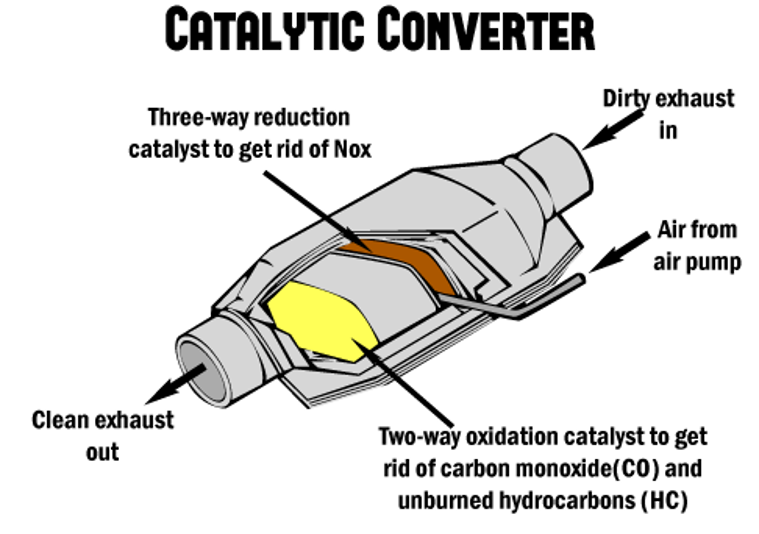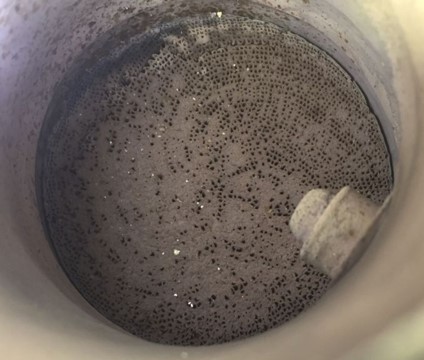
A catalytic converter is a large filter situated in the exhaust system of petrol engines. Gases from the combustion cycle of a petrol engine enter the CAT and flow over the catalyst, chemical reactions take place on its surface, breaking apart the pollutant gases and converting them into other gases that are safe enough to blow harmlessly out into the atmosphere.
Inside the CAT, gases flow through a dense honeycomb structure made from a ceramic and coated with a catalyst made from platinum or a similar, platinum-like metal such as palladium or rhodium. The honeycomb structure means the gases touch a bigger surface area of catalyst at once, so they’re converted more quickly and efficiently.
Typically, there are two different catalysts in a catalytic converter:
One thing to note concerning catalytic converters is that they require the use of unleaded fuel, because the lead in conventional fuel damages the catalyst and prevents it from taking up the pollutants in exhaust gases.

As an owner/driver of a petrol-powered vehicle you need to clean the CAT regularly as this will save you money in operating costs and prevent costly downtime in the long run.
Maintenance schedules or cleaning cycles vary according to the type of vehicle and how your vehicle is being used.
To keep your CAT’s optimal operating performance, we suggest a clean at least every 50,000km or 24 months. Shorter timeframes may be needed if your vehicle has been exposed to:
For vehicles that operate on the highway at least once a week or more for periods of at least 30 minutes at a time, we recommend a full CAT service and clean every 100,000km providing the below issues have not affected the operation of the CAT.

Audi A4 Blocked Catalytic convertor
Exhaust Clean Australia guarantees the fastest turnaround times on the market due to our revolutionary Flash Clean technology. This patented Italian made machine is the best of the best, guaranteeing the fastest clean and the very best results or your money back.
We can pick-up from your workshop and deliver your CAT back in as little as 3 hours. We offer a range of services, including:
If your CAT is oil soaked due to an engine component failure allow extra time for an additional step in the cleaning process to return your CAT back to its original state.
Exhaust Clean Australia offer warranty on all our workmanship where the vehicle is operated according to manufacturer’s specification.
From as little as $250. Compare that the cost of a replacement CAT that could set you back anywhere from $500-$3000. Cleaning your CAT is a very cheap cost alternative for your car, truck or machine.
There are some products on the market and homemade remedies that claim to be able to clean CAT’s. They are ineffective at removing contaminant stuck deep in the Cat core and a waste of your hard-earned money and time. Exhaust Clean Australia, using the powerful Flash Clean technology can clean your CAT and make it like new again!
To help prevent your CAT from being contaminated ensure that the vehicle’s service schedule is adhered to, correct engine oil is used and best of all preventative maintenance. Find an independent mechanic that is familiar with your make and model of vehicle and is experienced in servicing your type of vehicle. This will ensure that they have the correct knowledge of your vehicle and will know all the tips and tricks in fault finding any problems.
CAT systems are technical, and some mechanics may not fully understand their complex operation. In our experience that also includes some dealerships. Some workshops may use the “it needs replacing” method hoping it’ll solve the fault, but inevitably your bank balance will cop a hiding! Try to find a specialist workshop that frequently deal with CAT systems and understand how they work. They’ll be able to pinpoint the cause of the fault and only replace or repair the parts that are necessary.
Exhaust Clean Australia can provide a removal and refit service of your CAT at our workshop for all vehicle’s sizes. We can also provide a list of recommended mechanics in your area that can perform the removal and fitting service for you, while ensuring that your CAT is still being cleaned by the best in the business.
Exhaust Clean Australia will not clean cracked or broken catalytic converters.
No, it’s illegal to remove or delete your CAT. Your vehicle has been designed by the manufacturer to operate with a CAT system. It is illegal and will also void the manufacturer’s warranty on your vehicle and Australian consumer law protections. Removal or deletion of your CAT will also impact your vehicle’s insurance policy due to fire risk.
CAT’s are fitted to enable the vehicle to comply with the Australian Design Rules (ADR) emission requirement levels.
The relevant ADR for light vehicles is ADR79/03
https://www.legislation.gov.au/Details/F2012C00283/Html/Volume_1
https://www.legislation.gov.au/Details/F2011L02015/Html/Volume_2
The relevant ADR for heavy vehicles is ADR80/01
https://www.legislation.gov.au/Details/F2005L03392/Supporting%20Material/Text
It is illegal to operate a vehicle that does not meet the ADR requirements so removing or deleting a CAT will result in non-compliance with all relevant emissions ADR’s.
In addition to commonwealth legislation, each state and territory also have additional legislation that require CAT’s to be fitted and operated in accordance with manufacturer requirements.
Don’t be fooled by dodgy operators that claim to electronically delete the operation of your CAT without detection. Authorities are now cracking down on engine tuning shops and vehicle owners who employ this practice, using sophisticated tools to identify vehicles suspected of having no CAT or modified CAT’s originally fitted as OEM equipment. Stiff prison sentences are now being applied for this practice, with numerous prison sentences already handed down.